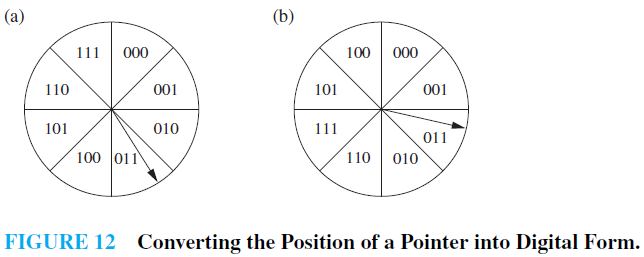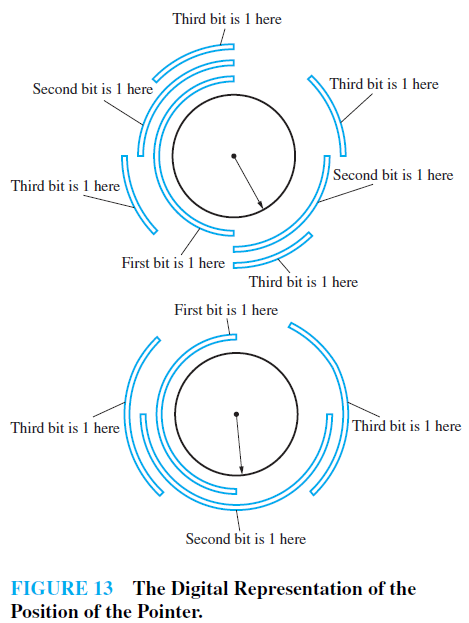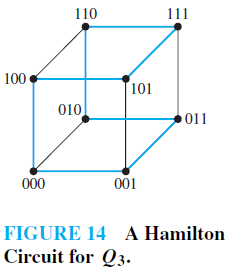Hamilton Paths And Circuits
THEOREM 1 DIRAC’S THEOREM If G is a simple graph with n vertices with n ≥ 3 such that the degree of every vertex in G is at least n/2, then G has a Hamilton circuit.
THEOREM 2 ORE’S THEOREM If G is a simple graph with n vertices with n ≥ 3 such that deg(u) deg(v) ≥ n for every pair of nonadjacent vertices u and v in G, then G has a Hamilton circuit.
Dirac’s theorem can be proved as a corollary to Ore’s theorem because the conditions of Dirac’s theorem imply those of Ore’s theorem. Both Ore’s theorem and Dirac’s theorem provide sufficient conditions for a connected simple graph to have a Hamilton circuit. However, these theorems do not provide necessary conditions for the existence of a Hamilton circuit. For example, the graph C5 has a Hamilton circuit but does not satisfy the hypotheses of either Ore’s theorem or Dirac’s theorem, as the reader can verify.
The best algorithms known for finding a Hamilton circuit in a graph or determining that no such circuit exists have exponential worst-case time complexity (in the number of vertices of the graph). Finding an algorithm that solves this problem with polynomial worst-case time complexity would be a major accomplishment because it has been shown that this problem is NP-complete. Consequently, the existence of such an algorithm would imply that many other seemingly intractable problems could be solved using algorithms with polynomial worst-case time complexity.
Applications of Hamilton Circuits: Hamilton paths and circuits can be used to solve practical problems. For example, many applications ask for a path or circuit that visits each road intersection in a city, each place pipelines intersect in a utility grid, or each node in a communications network exactly once. Finding a Hamilton path or circuit in the appropriate graph model can solve such problems. The famous traveling salesperson problem or TSP (also known in older literature as the traveling salesman problem) asks for the shortest route a traveling salesperson should take to visit a set of cities. This problem reduces to finding a Hamilton circuit in a complete graph such that the total weight of its edges is as small as possible.
EXAMPLE 3 Gray Codes The position of a rotating pointer can be represented in digital form. One way to do this is to split the circle into 2n arcs of equal length and to assign a bit string of length n to each arc. Two ways to do this using bit strings of length three are shown in Figure 12.
The digital representation of the position of the pointer can be determined using a set of n contacts. Each contact is used to read one bit in the digital representation of the position. This is illustrated in Figure 13 for the two assignments from Figure 12.
When the pointer is near the boundary of two arcs, a mistake may be made in reading its position. This may result in a major error in the bit string read. For instance, in the coding scheme in Figure 12(a), if a small error is made in determining the position of the pointer, the bit string 100 is read instead of 011. All three bits are incorrect! To minimize the effect of an error in determining the position of the pointer, the assignment of the bit strings to the 2n arcs should be made so that only one bit is different in the bit strings represented by adjacent arcs. This is exactly the situation in the coding scheme in Figure 12(b). An error in determining the position of the pointer gives the bit string 010 instead of 011. Only one bit is wrong.
A Gray code is a labeling of the arcs of the circle such that adjacent arcs are labeled with bit strings that differ in exactly one bit. The assignment in Figure 12(b) is a Gray code.We can find a Gray code by listing all bit strings of length n in such a way that each string differs in exactly one position from the preceding bit string, and the last string differs from the first in exactly one position.We can model this problem using the n-cubeQn. What is needed to solve this problem is a Hamilton circuit in Qn. Such Hamilton circuits are easily found. For instance, a Hamilton



circuit for Q3 is displayed in Figure 14. The sequence of bit strings differing in exactly one bit produced by this Hamilton circuit is 000, 001, 011, 010, 110, 111, 101, 100.
Gray codes are named after Frank Gray, who invented them in the 1940s at AT&T Bell Laboratories to minimize the effect of errors in transmitting digital signals.